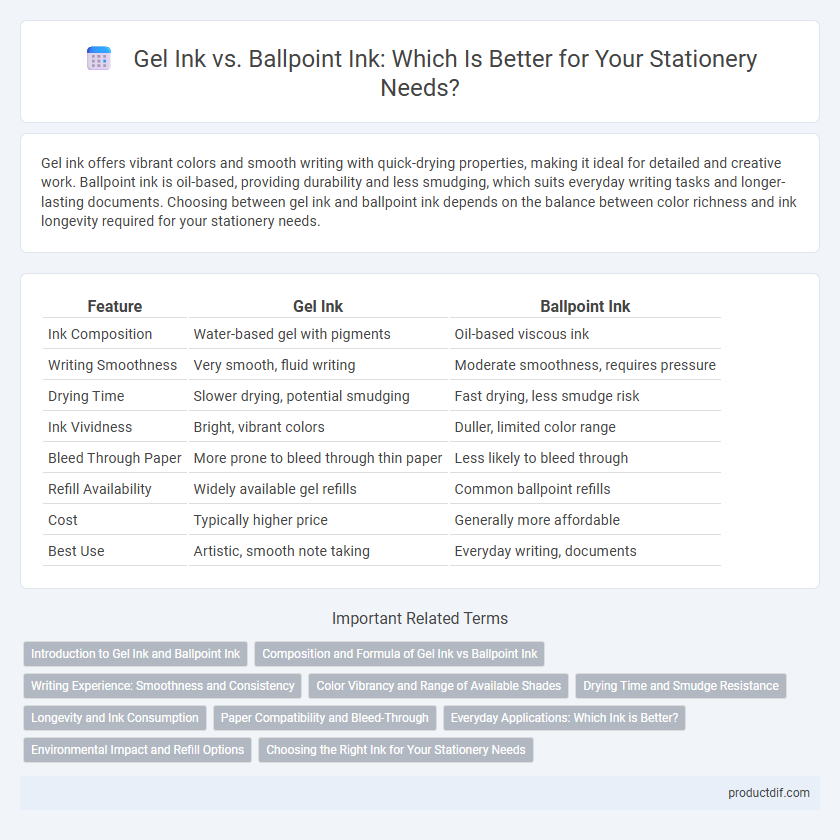Gel ink offers vibrant colors and smooth writing with quick-drying properties, making it ideal for detailed and creative work. Ballpoint ink is oil-based, providing durability and less smudging, which suits everyday writing tasks and longer-lasting documents. Choosing between gel ink and ballpoint ink depends on the balance between color richness and ink longevity required for your stationery needs.
Table of Comparison
| Feature | Gel Ink | Ballpoint Ink |
|---|---|---|
| Ink Composition | Water-based gel with pigments | Oil-based viscous ink |
| Writing Smoothness | Very smooth, fluid writing | Moderate smoothness, requires pressure |
| Drying Time | Slower drying, potential smudging | Fast drying, less smudge risk |
| Ink Vividness | Bright, vibrant colors | Duller, limited color range |
| Bleed Through Paper | More prone to bleed through thin paper | Less likely to bleed through |
| Refill Availability | Widely available gel refills | Common ballpoint refills |
| Cost | Typically higher price | Generally more affordable |
| Best Use | Artistic, smooth note taking | Everyday writing, documents |
Introduction to Gel Ink and Ballpoint Ink
Gel ink uses water-based pigments suspended in a gel, providing vibrant, smooth writing with quick drying times and minimal smudging, making it ideal for detailed and colorful work. Ballpoint ink is oil-based, thicker, and more viscous, offering reliable, mess-free writing with longer-lasting ink supply and durability on various paper types. Both inks serve different writing needs, with gel ink emphasizing smoothness and color intensity, while ballpoint ink focuses on practicality and longevity.
Composition and Formula of Gel Ink vs Ballpoint Ink
Gel ink is composed of pigment suspended in a water-based gel, resulting in smooth and vibrant writing with quick-drying properties. Ballpoint ink contains oil-based dyes or pigments in a viscous, paste-like formula, providing durability and resistance to smudging. The water-based gel ink offers more vivid colors and fluidity, while the thicker oil-based ballpoint ink excels in longevity and writing on various surfaces.
Writing Experience: Smoothness and Consistency
Gel ink offers a smoother and more consistent writing experience compared to ballpoint ink due to its water-based formula that flows evenly across the paper. Ballpoint ink, made from oil-based substances, tends to require more pressure and can result in uneven lines or occasional skipping. The consistent flow of gel ink enhances precision and comfort, making it ideal for extended writing sessions.
Color Vibrancy and Range of Available Shades
Gel ink offers superior color vibrancy and a broader range of available shades compared to ballpoint ink, making it ideal for projects requiring bright and diverse colors. The water-based formula in gel pens allows for more intense pigments, resulting in richer and more eye-catching writing or artwork. Ballpoint ink, typically oil-based, tends to produce duller tones with fewer shade options, limiting creative expression.
Drying Time and Smudge Resistance
Gel ink offers faster drying times compared to traditional ballpoint ink, reducing the likelihood of smudges on various paper types. Ballpoint ink, composed of oil-based ink, dries slower but provides better longevity and durability on different surfaces. For quick note-taking and clean, smudge-free writing, gel ink is often preferred, while ballpoint ink excels in archival quality and write-through resistance.
Longevity and Ink Consumption
Gel ink pens offer vibrant, smooth lines but tend to consume ink faster and dry out quicker compared to ballpoint ink, which is oil-based and designed for longevity. Ballpoint ink's thicker viscosity allows for extended writing periods and less frequent refills, making it ideal for high-volume use. Gel ink's water-based formula can run out more quickly but provides superior color intensity and precision in everyday writing tasks.
Paper Compatibility and Bleed-Through
Gel ink pens feature water-based ink that offers vibrant color and smooth flow but may cause bleed-through on thin or low-quality paper due to its liquid consistency. Ballpoint ink, composed of oil-based ink, dries quickly and performs well on a wider range of paper types, minimizing bleed-through and smudging. For professional documents or notebooks with thinner paper, ballpoint pens provide superior compatibility by reducing ink absorption and preserving paper integrity.
Everyday Applications: Which Ink is Better?
Gel ink offers smoother writing and vibrant colors ideal for detailed notes and creative projects, enhancing everyday handwriting quality. Ballpoint ink excels in quick-drying, smudge-resistant properties, making it suitable for fast note-taking and forms that require immediate handling. For daily applications, gel ink is preferred for a polished look, while ballpoint is better for durability and convenience.
Environmental Impact and Refill Options
Gel ink pens typically use water-based gel ink that is often more environmentally friendly due to lower volatile organic compound emissions compared to the oil-based ink in ballpoint pens. Gel ink refills, while available, tend to have shorter lifespans and may require more frequent replacement, contributing to waste, whereas ballpoint ink refills generally last longer and are widely accessible, reducing overall refill consumption. Choosing refillable options in both gel and ballpoint pens can significantly minimize plastic waste and environmental footprint by extending the life of the pen body.
Choosing the Right Ink for Your Stationery Needs
Gel ink offers vibrant, smooth writing with quick-drying properties ideal for detailed note-taking and artistic projects, while ballpoint ink provides durability and resistance to smudging, perfect for everyday use and official documents. Selecting the right ink depends on your specific stationery needs, such as the desired writing texture, ink longevity, and paper type compatibility. Consider gel ink for bold, smooth lines on coated paper and ballpoint ink for reliable performance on standard office paper.
Gel Ink vs Ballpoint Ink Infographic

 productdif.com
productdif.com